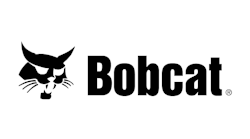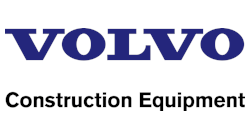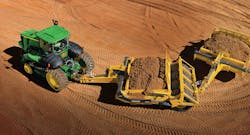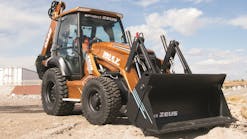The manufacturers have increased power levels, improved hydraulics and controls, and now offer more comfortable and roomy cabs. Virtually all backhoes can mount a wide variety of attachments. Here we explain what’s new in the latest backhoe loader models from Caterpillar, John Deere, CASE, Kubota, Terex, JCB, and Volvo. We have also added skid-steer loaders from Bobcat.
Caterpillar offers four backhoe loader models in North America. Three of them were introduced in early 2012: the 416F, which Cat aims at the rental and governmental markets; the 420F/420F IT, which is the most popular backhoe loader that Caterpillar sells in North America; and the 430F/430 IT, which is popular where lifting and digging requirements are tough. The 450F was introduced recently. It’s powerful for a backhoe loader and is sometimes used in place of a hydraulic excavator.
The manufacturers have increased power levels, improved hydraulics and controls, and now offer more comfortable and roomy cabs. Virtually all backhoes can mount a wide variety of attachments. Here we explain what's new in the latest backhoe loader models from Caterpillar, John Deere, CASE, Kubota, Terex, JCB, and Volvo. We have also added skid-steer loaders from Bobcat. Caterpillar offers four backhoe loader models in North America. Three of them were introduced in early 2012: the 416F, which Cat aims at the rental and governmental markets; the 420F/420F IT, which is the most popular backhoe loader that Caterpillar sells in North America; and the 430F/430 IT, which is popular where lifting and digging requirements are tough. The 450F was introduced recently. It's powerful for a backhoe loader and is sometimes used in place of a hydraulic excavator. [text_ad] Cat's IT configuration refers to the front linkage-parallel lift that comes with a standard hydraulic quick-coupler to allow changing work tools (such as bucket to forks) quickly. Parallel lift makes it easier to handle palletized materials by keeping the load level throughout the lift range. The 416F, 420F, and 430F are center-pivot machines featuring design changes, including a new Cat C4.4 Acert engine that meets Tier 4 Interim emissions standards, greater lift capacity, more bucket breakout force, and increased backhoe control. Features retained in the design of F Series models from their E Series counterparts include a load-sensing, closed-center hydraulic system and the Cat four-speed Power Shuttle transmission for on-the-go directional and range shifting. Also included are an excavator-style boom, for added clearance when digging over obstacles or loading trucks, and an ergonomic operator's station. The electronically controlled Cat C4.4 Acert engine uses a high-pressure common-rail fuel system for operating efficiency. It is equipped with the Cat Nox Reduction System and a diesel particulate filter for emissions reduction. Net horsepower remains unchanged for the 416F and 420F, at 87 and 93, respectively, but increases to 109 for the 430F. Driveline refinement for the three Cat models includes a more aggressive torque converter in the 420F for improved performance when both loading and roading, and hydraulically boosted brakes for the 416F. Both the 420F and 430F have a new electronic pump torque limiter for improved power management and improved hydraulic performance. Hydraulic refinement also includes more precisely tuned spools in the backhoe valve. Cat says performance at the loader end is improved with the new F Series models. New lift arms for both single-tilt and IT models increase maximum hinge-pin height by 5%, maximum dump height by 7%, bucket breakout force by as much as 9%, and lift capacity by as much as 13%. In addition, loader changes result in improved material retention for IT models. The four-wheel-drive Cat 450F backhoe loader builds on the performance of its 450E predecessor with a more efficient overall design, including more horsepower, electronic control of the hydraulic system, serviceability improvements, and added operator comfort. The 450F is powered by a Cat C4.4 Acert engine meeting USEPA Tier 4 Interim/EU Stage IIIB emission standards. The 450F is available with a hydraulic thumb, pin-puller coupler, and a range of compatible work tools, including buckets with integral forks, hammers, and plate compactors. New Bobcat Skid-Steers In January 2013, Bobcat Co. made available the 500 frame-size skid-steer and compact track loaders. Bobcat says the seven medium-size machines make up the most popular size class in the Bobcat loader family, providing operators with upgrades that include increased visibility, a more comfortable cab, and easier serviceability. The Bobcat lineup includes the S510, S530, S550, S570, and S590 skid-steer loaders, and the T550 and T590 compact track loaders. The S510, S550, and T550 feature a radius lift path, providing operators the reach and visibility they require for dumping over a wall, backfilling, or loading flatbed trucks. The S530, S570, S590, and T590 models have a vertical lift path, providing operators the ability to lift heavier loads higher and making it easier to clear high-sided truck boxes and hoppers. The M-Series vertical lift path machines feature an increased lift height over the equivalent K-Series models. The 500 frame-size loaders feature a cab-forward design that not only gives the machines a different look, but also moves the operator closer to the attachment and provides good visibility in all directions. Bobcat says the loaders have the largest cab door opening on the market, offering superior visibility to the cutting edge of the bucket or to the corners of an attachment. The cab door threshold has been lowered and the overall surface of the door has increased more than 40% to provide improved visibility and make it easier for operators to enter and exit the cab. The height of the cab has been increased, providing additional headroom, while still keeping the overall machine size small enough to operate in tight spaces. Windows on the sides and rear of the cab have also been increased in size to provide more visibility to the tires and back of the machine. The larger top window makes it easier and more comfortable for the operator to see an attachment with the lift arms raised, an advantage when loading trucks or performing other tasks. Bobcat's auxiliary hydraulic quick-couplers are mounted directly to the front plate of the lift arm to provide a solid mounting, and hoses are routed through the loader arms for better protection. A guard bar extends in front of the coupler for added security and a steel tailgate prevents items from penetrating the engine compartment. Backhoe Loaders From CASE CASE Construction Equipment manufactures four backhoe models that feature the following specs:- 580N: 78 horsepower; 14-foot, 10-inch digging depth
- 580 Super N: 95 horsepower; 14-foot, 6-inch digging depth
- 580 Super N WT: 95 horsepower; 14-foot, 6-inch digging depth
- 590 Super N: 108 horsepower; 15-foot, 6-inch digging depth
- 310K EP (70 horsepower; 14-foot, 3-inch digging depth)
- 310K (88 horsepower; 14-foot, 3-inch digging depth)
- 310SK (96 horsepower; 14-foot, 6-inch digging depth)
- 310SK TC (102 horsepower; 14-foot, 11-inch digging depth)
- 410K (107 horsepower; 15-foot, 10-inch digging depth)
- 410K TC (106 horsepower; 16-foot, 1-inch digging depth)
- 710K (130 horsepower; 17-foot, 10-inch digging depth)
Cat’s IT configuration refers to the front linkage-parallel lift that comes with a standard hydraulic quick-coupler to allow changing work tools (such as bucket to forks) quickly. Parallel lift makes it easier to handle palletized materials by keeping the load level throughout the lift range.
The 416F, 420F, and 430F are center-pivot machines featuring design changes, including a new Cat C4.4 Acert engine that meets Tier 4 Interim emissions standards, greater lift capacity, more bucket breakout force, and increased backhoe control. Features retained in the design of F Series models from their E Series counterparts include a load-sensing, closed-center hydraulic system and the Cat four-speed Power Shuttle transmission for on-the-go directional and range shifting. Also included are an excavator-style boom, for added clearance when digging over obstacles or loading trucks, and an ergonomic operator’s station.
The electronically controlled Cat C4.4 Acert engine uses a high-pressure common-rail fuel system for operating efficiency. It is equipped with the Cat Nox Reduction System and a diesel particulate filter for emissions reduction. Net horsepower remains unchanged for the 416F and 420F, at 87 and 93, respectively, but increases to 109 for the 430F.
Driveline refinement for the three Cat models includes a more aggressive torque converter in the 420F for improved performance when both loading and roading, and hydraulically boosted brakes for the 416F. Both the 420F and 430F have a new electronic pump torque limiter for improved power management and improved hydraulic performance. Hydraulic refinement also includes more precisely tuned spools in the backhoe valve.
Cat says performance at the loader end is improved with the new F Series models. New lift arms for both single-tilt and IT models increase maximum hinge-pin height by 5%, maximum dump height by 7%, bucket breakout force by as much as 9%, and lift capacity by as much as 13%. In addition, loader changes result in improved material retention for IT models.
The four-wheel-drive Cat 450F backhoe loader builds on the performance of its 450E predecessor with a more efficient overall design, including more horsepower, electronic control of the hydraulic system, serviceability improvements, and added operator comfort. The 450F is powered by a Cat C4.4 Acert engine meeting USEPA Tier 4 Interim/EU Stage IIIB emission standards. The 450F is available with a hydraulic thumb, pin-puller coupler, and a range of compatible work tools, including buckets with integral forks, hammers, and plate compactors.
New Bobcat Skid-Steers
In January 2013, Bobcat Co. made available the 500 frame-size skid-steer and compact track loaders. Bobcat says the seven medium-size machines make up the most popular size class in the Bobcat loader family, providing operators with upgrades that include increased visibility, a more comfortable cab, and easier serviceability.
The Bobcat lineup includes the S510, S530, S550, S570, and S590 skid-steer loaders, and the T550 and T590 compact track loaders. The S510, S550, and T550 feature a radius lift path, providing operators the reach and visibility they require for dumping over a wall, backfilling, or loading flatbed trucks.
The S530, S570, S590, and T590 models have a vertical lift path, providing operators the ability to lift heavier loads higher and making it easier to clear high-sided truck boxes and hoppers. The M-Series vertical lift path machines feature an increased lift height over the equivalent K-Series models.
The 500 frame-size loaders feature a cab-forward design that not only gives the machines a different look, but also moves the operator closer to the attachment and provides good visibility in all directions.
Bobcat says the loaders have the largest cab door opening on the market, offering superior visibility to the cutting edge of the bucket or to the corners of an attachment. The cab door threshold has been lowered and the overall surface of the door has increased more than 40% to provide improved visibility and make it easier for operators to enter and exit the cab. The height of the cab has been increased, providing additional headroom, while still keeping the overall machine size small enough to operate in tight spaces.
Windows on the sides and rear of the cab have also been increased in size to provide more visibility to the tires and back of the machine. The larger top window makes it easier and more comfortable for the operator to see an attachment with the lift arms raised, an advantage when loading trucks or performing other tasks.
Bobcat’s auxiliary hydraulic quick-couplers are mounted directly to the front plate of the lift arm to provide a solid mounting, and hoses are routed through the loader arms for better protection. A guard bar extends in front of the coupler for added security and a steel tailgate prevents items from penetrating the engine compartment.
Backhoe Loaders From CASE
CASE Construction Equipment manufactures four backhoe models that feature the following specs:
- 580N: 78 horsepower; 14-foot, 10-inch digging depth
- 580 Super N: 95 horsepower; 14-foot, 6-inch digging depth
- 580 Super N WT: 95 horsepower; 14-foot, 6-inch digging depth
- 590 Super N: 108 horsepower; 15-foot, 6-inch digging depth
CASE touts its Power Lift technology as a key differentiating feature on the N Series backhoe loaders. Power Lift channels hydraulic power directly to the boom with the touch of a button. This allows the backhoe to increase its lifting capacity over previous and competitive models while maintaining low engine speeds. It has also shown to improve dipper and bucket forces. Newer 14-foot models with Power Lift perform well compared with older 15-foot machines.
N Series backhoes feature cooled exhaust gas recirculation (CEGR) emissions-control technology to achieve Tier 4 Interim certification. CASE says fuel burns cleaner and the engine delivers more horsepower, faster response, and a minimum of 5% better fuel efficiency under load compared with older engines.
Other standard N Series features include automatic Ride Control on four-wheel-drive models. Ride Control engages at travel speeds and helps to reduce bucket spillage. N Series backhoes also feature a robotically welded boom. CASE says that improves durability and gives the backhoe greater reliability in demanding such applications as demolition. Significant testing went into this boom design to ensure that it meets and exceeds the performance of previous booms.
CASE SiteWatch, a telematics system, is standard equipment on N Series backhoes. Telematics permits an owner or dealer to monitor the machine on a remote computer screen. This technology does not typically come standard on backhoe loaders, but CASE management felt the technology would offer an important differentiating feature to the backhoes.
Advantages of a telematics system as it relates to backhoes include improved equipment maintenance, a better understanding of equipment utilization, reduced idling, and enhanced equipment security.
SiteWatch serves as an excellent method of tracking maintenance intervals, eliminating the old haphazard notebooks or whiteboards with sloppily written status updates. Alerts can be sent when a machine is due for service, and contractors can better schedule service activities with this knowledge. It’s also excellent for record keeping, as the system stores 18 months of data (longer if you download it and save it).
Telematics also gives the equipment owner better insight into how that machine is being used. Owners can easily track engine hours and compare idle engine time to working engine time. The ability to identify engine idling can also empower the equipment owner with the knowledge needed to coach the operator on more efficient operating techniques that don’t waste fuel and put extra wear and tear on the engine.
Eight Models From John Deere
John Deere provides seven models in its K-Series backhoe loader line:
- 310K EP (70 horsepower; 14-foot, 3-inch digging depth)
- 310K (88 horsepower; 14-foot, 3-inch digging depth)
- 310SK (96 horsepower; 14-foot, 6-inch digging depth)
- 310SK TC (102 horsepower; 14-foot, 11-inch digging depth)
- 410K (107 horsepower; 15-foot, 10-inch digging depth)
- 410K TC (106 horsepower; 16-foot, 1-inch digging depth)
- 710K (130 horsepower; 17-foot, 10-inch digging depth)
The John Deere K-Series, introduced in March 2012, offers several new features that increase productivity and uptime and lower daily operating costs. To increase productivity, the K-Series offers a certified Interim Tier 4 (IT4) John Deere PowerTech engine. A new AutoShift transmission enables smooth shifting and improves operator comfort. A five-speed transmission increases speed for road applications and transport. A single, user-friendly loader lever with integrated electrohydraulic (EH) auxiliary proportional control eliminates the need to simultaneously operate two levers with one hand when using a multipurpose loader bucket.
“The new K-Series includes components that will take a beating and keep on digging,” says Louann Hausner, backhoe loaders and tractor loaders marketing manager, John Deere Construction & Forestry. An example is the sealed switch module (SSM) now available on five K-Series models. Keyless start and machine security come standard on all models with an SSM. In addition, engine access was improved again with a greater hood-tilting angle. JDLink, John Deere’s telematics system, comes standard on all backhoe models for remote diagnostic and customer management capability.
In an effort to lower daily operating costs, John Deere is providing smart technology that can help reduce fuel costs with auto idle and auto shutdown, both available on the K-Series. In addition, an economy mode setting provides an RPM threshold for maximum productivity and optimal fuel savings. An electronically controlled, variable-speed cooling fan reduces horsepower draw on the engine for quieter operation and improved fuel economy. The K-Series also introduced a new 310K EP backhoe providing the easiest IT4 solution with maximum productivity.
Backhoe technology has expanded from being button-activated and add-on to being smart and integrated. With Auto Idle and Auto Shutdown, Deere backhoes enable owners to save on fuel and noise levels by automatically reducing the amount of idle time. With JDLink being integrated as standard equipment, Deere says its backhoe owners have a logistics optimizer, machine productivity maximizer, and remote diagnostic enabler with every Deere backhoe.
The John Deere 310K EP is designed specifically for rental and large contractor customers. The EP model provides a 70-horsepower engine with IT4 power without needing any aftertreatment technology. This eliminates the need for additional operator training or extra monitoring of machines.
Nine Models From JCB
JCB offers nine models of backhoes, ranging from one with 50 horsepower and an 8-foot, 4-inch digging depth up to a 109-horsepower model with a 21-foot, 6-inch digging depth with an extendable dipper. The company does plan new introductions in its backhoe range at Conexpo. The JCB EcoMAX engine, available in the 3CX through 4CX Super models, is Tier 4 Interim compliant without the use of aftertreatment such as DPF and SCR. The EcoMAX uses up to 9% less fuel than JCB’s Tier 3 engine.
Backhoe Loaders From Kubota
Kubota offers four models of backhoe loaders, ranging from the B26, with 19.5 horsepower and an 8-foot digging depth, up to the M59, with 59 horsepower and a 12-foot digging depth.
The smallest of the range, the Kubota B26, has four-wheel drive with 1,300-pound loader lifting capacity. With a lift height of 7 feet, 10 inches, the B26’s loader increases productivity while featuring a skid-steer-style quick-attach and auxiliary hydraulics to expand attachment versatility. A quick-attach backhoe allows operators to install Category I implements to tailor the B26 to their specific needs.
The L39 model is powered by Kubota’s 39-horsepower diesel engine. It’s a four-wheel drive model that features an electronically controlled hydraulic glide shift transmission (GST). That permits clutchless, on-the-go shifting to increase loader production. The L39’s loader delivers 3,560 pounds of breakout force, 2,200 pounds of lift capacity, and a 9-foot, 6-inch lift height. The auto-leveling valve automatically keeps the bucket or pallet fork horizontal as the loader boom raises and lowers. The quick-attach, 10-foot-digging-depth backhoe features an independent boom swing pump for increased efficiency.
Kubota says its L45 backhoe loader, with 45 horsepower, offers the versatility of three machines in one: a loader, a backhoe, and a Category I three-point hitch for rear-mounted attachments. With a slanted boom design and braceless frame for excellent visibility, the loader is designed with a lifting capacity of 2,200 pounds. The backhoe offers a 10-foot digging depth and backhoe crawling mode to reposition along trenches.
Kubota’s 59-horsepower M59 backhoe loader has four-wheel-drive for power and stability, an integrated main frame and a heavy-duty rear axle for extended life and smooth stopping performance. The M59’s backhoe has a 12-foot digging depth and offers more power than Kubota’s previous models. The M59 has a bucket digging force of over 7,600 pounds and lifting power of 3,960 pounds.
Terex Offers Its TLB840
Powered by an electronic Tier 4 interim Perkins engine and an optional four-speed power-synchro transmission with automatic shifting, the 94-horsepower Terex TLB840 backhoe loader has a digging depth of 14 feet, 9 inches (extended to 18 feet, 1 inch). The machine has a backhoe reach up of 18 feet, 9 inches (extended 21 feet, 11 inches). The TLB840 is designed with a slew system that provides high torque for easier backfilling and slewing uphill.
With a loading height of 11 feet, 3 inches, the Terex TLB840 can load high-sided trucks. Terex says that with 10,485 pounds of bucket breakout force, a loader lift capacity of 7,291 pounds, and bucket capacity of 1.32 cubic yards, this backhoe loader offers high-capacity production. With the “return to dig” feature at the press of a button, the TLB840 reduces cycle times and provides quick loading capability. The hydro-mechanical self-leveling feature on the TLB840 enables the operator to avoid spillage and allows for load retention at full height. The hydraulic unload button controls the loader’s lift speed, as well as boosts the machine’s pushing performance.
Terex introduced its Tier 4 interim solution, the TLB840 backhoe loader, in April 2013. The Tier 4i-compliant engine on the TLB840 is designed with EGR (Exhaust Gas Recirculation) technology, which is well suited for lower horsepower engines operating in high-duty applications. EGR engines incorporate diesel oxidation catalyst systems and sometimes diesel particulate filters to reduce nitrogen oxide and particulate matter exhaust emissions. The new Perkins Stage III B/Tier 4i EGR engines, like the one in the Terex TLB840, include a diesel particulate filter and allow auto-idle to be incorporated in machine.
The “deep dig” extendable dipper stick is new on the TLB840. With an optional thumb attachment, operators are able to clamp objects and materials between the bucket and dipper with ease. Terex says its backhoe loaders increase productivity by increasing bucket rotation. The bucket linkage design allows operators to drive into a pile and roll back 45 degrees. These machines also dump at 57 degrees for greater fill capacity and better discharge.
The specifications of Terex backhoe loaders continue to improve. Terex designs its backhoe loader line with the hydraulic capacity and flow to power many hydraulic attachments, including 1.32-cubic-yard loader buckets, multiple-purpose, high-capacity, and grapple-front buckets, thumbs, hydraulic breakers, forks, angle dozers, augers, compactors, and a broad range of rear buckets.
Two Models From Volvo
With the launch of its BL60B and BL70B backhoe loaders, Volvo Construction Equipment has redesigned its backhoe loader range. With an average operating weight that ranges from 17,500 pounds to 19,500 pounds, and gross power of 83 horsepower to 98 horsepower, Volvo says the BL60B and BL70B were designed and built with power, strength, long life, and efficiency in mind.
The one-piece chassis, loader arm, and excavator boom are all made from high-quality steel and robotically welded, giving precise, constant weld runs for structural integrity. The loader arm has a box-welded design and is reinforced with a cross-tube. The larger excavator boom has a narrow, tall arch design that is inherently strong and uses a closed, box-welded approach with fewer components and welds for durability and performance. The boom allows excellent visibility into the trench as well as enabling closer proximity to the truck for loading. The cast iron kingpost offers flexibility of movement and swing.
Compared with previous models, the Volvo BL60B and BL70B feature new controls. The machines are fitted with two floor-mounted ergonomic levers that give optimum grip for the operator’s hand movements when operating the excavator. The right lever is fitted with a horn for safety, and the left lever can have an optional fingertip button. This button controls the two-way auxiliary hydraulic line required when using double acting excavator attachments.
Fitted with either 16.5-inch or 18-inch front tires, these machines have a small turning radius and are extremely maneuverable, as well as easier to position onsite. Helped by a new cast bucket linkage design, the bucket can rotate 205 degrees, allowing vertical digging in all positions without repositioning the machine.
The BL60B and BL70B have the latest four-cylinder 3.8-liter Volvo engines. These high-torque engines meet the requirements of the Tier 4 Interim emissions legislation. Volvo says the torque converter on these machines is one of the largest in the industry and has excellent peak torque and torque rise. A differential lock on the rear axle is engaged via a foot switch on the side of the brake pedal and provides maximum rear wheel grip over slippery surfaces.
Both the loader and excavator benefit from flow sharing hydraulics that enable multifunctioning for efficient and smooth operation. The BL70B features load-sensing hydraulics that constantly adapt to the needs of the job at hand. In such applications as load and carry, where speed is important, the system efficiently delivers the required flow.
The Volvo cab has 15% more space than before, and the room between the operator’s seat and the left side of the cab has been increased. So has space around the excavator’s mechanical controls or pilot towers, making the position change between loader and excavator easier and more convenient. There is also a larger area to store personal items. The seat, steering controls, and instruments are all designed to lower fatigue and keep operators alert and in control.








